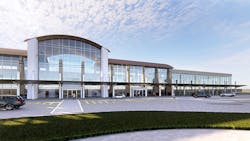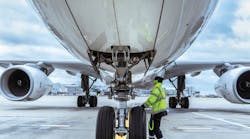According to FAA data dating back to 2016, air carrier enplanements at the MidAmerica St. Louis Airport (BLV) were at 71,039, and within six years they have more than doubled to 166,890. To alleviate these growing pains, the airport added an additional 41,000 square feet to the existing terminal.
HOK Senior Project Architect David Camp said the primary goal in the expansion was to improve the overall passenger experience.
“We approached this by providing ample space for TSA security screening, adding gates, reorganizing and streamlining the passenger flow from curb to gate and gate to curb, removing accessibility barriers, improving wayfinding, and refreshing finishes,” he said.
Camp said since its construction in the late 1990s, the airport had seen minimal upgrades to enhance the passenger experience, with only piecemeal improvements made to security and accessibility over the years.
“Increasing passenger volumes were taxing the gate and facility capacity. Our big picture concept was to add gates and space for integrated security screening while upgrading accessibility features to modern standards,” Camp said.
Terminal Features
In addition to renovating all existing restrooms to current standards, the airport added a nursing room, family assist restrooms and a service animal relief area. Previously the pet relief area was only offered outside the facility but is now available inside as well.
“Signage and wayfinding were unified and upgraded throughout the terminal. Charging ports were added to all boarding lounge seating, and we introduced a range of seating options that include work counters and club chairs,” Camp said. “The curbside is expanded and regraded to provide curbless access to the terminal for its full length.”
MidAmerica St. Louis Airport Director Bryan Johnson said the entire first level is dedicated to TSA to alleviate congestion.
“Not only do we have three lanes but we also can go to four lanes for passenger processing through the TSA checkpoint, and that was a game changer as well for the airlines as they look at growing here,” he said.
Johnson said in addition to that, the baggage screening devices have been moved from passenger eyesight.
“All these improvements from a securities screening standpoint, really make a huge difference as well,” Johnson said. “We all know the more pleasant and the more open, the more natural lighting, the more things that we see help us through those processes. That's what you would see here on the first level, just the TSA, the staff loves it, the passengers are talking about it. It's just such a better experience for the travelers using this airport.”
Another, less visible, improvement was the addition of a tornado shelter in the basement of the terminal.
“The airport is in a semi-rural location in the Midwest. Summer storms can quickly develop into destructive events and even tornados in which surface structures can be at risk of compromise. Recognizing that many people could gather in a lone, above grade structure like this on open ground, the airport decided it was prudent to create a basement space that could briefly shelter several hundred people should the need arise,” Camp said.
Johnson said the value of the improvements is the impact it makes on the community.
“I think the value there is really the commitment we make as an airport in this community to further support people as they look to travel, again, whether it's domestically or internationally,” Johnson said. “…when you blend all these things together, we've been an airport for 25 years, this is a really nice point in time to take that next step, bring these other amenities in, which the passengers will just thoroughly enjoy, where they'll improve their experience, it'll be a much more positive experience, and then also, generate additional interest from our terminal carriers as well as others.”
Future Plans: Sustainability and Electrification
Johnson said looking to the future, the airport plans to add solar-covered parking which will be a multi-year project with planning and design taking place in 2023 and 2024 and construction likely beginning in 2025.
“We're in the development stage or planning stage right now. We've done some research. We're looking at completing a financial analysis to figure out what the funding mechanism would be for that solar-covered parking,” he said. “But we really feel like we're at a pretty good point in time. We feel like our passengers are looking for those kinds of benefits, not just the covered parking, but knowing that the sun is being harvested and put back into the building.”
Another sustainability initiative that the airport is working on is a Charging Fuel Infrastructure (CFI) program.
“The idea behind it is that we can bring eight level-three charging stations to the airport, but not just for our passenger use, but for those traveling from coast-to-coast or north-to-south where they can come charge the vehicles, they can refresh themselves and then carry on with the travel,” Johnson said. “I think what's more important for airports, when you look at where they're located, the communities they serve, I think the airports have the opportunity to lead on supporting charging stations throughout the country by being part of this bigger network.”
Johnson said the current passenger boarding bridges incorporate sustainability practices such as PC air (preconditioned air) and the use of electricity instead of ground power units.
“We actually renovated or retrofitted our existing jet bridges to take advantage of some of those benefits and that we see through that sustainability,” he said.
The airport is also working on adding a new U.S. Customs and Border Protection facility at a Federal Inspection Station which Johnson said is 90% designed as of end of July.
“This will then allow us to accept international traffic into this airport, into the terminal,” he said. “So that is just getting underway. We call it our Phase Four Project. Phase Three was terminal expansion. We’re really excited about how one builds on the other and just fosters that energy and growth. Construction starts in November of this year. It'll be completed [at] the end of 2024. And this ties in with our air service development piece. We're working with a couple air carriers right now to bring in international to start international travel from MidAmerica.”
Camp said the terminal design sets the tone for future growth.
“We developed this expansion with the airport’s long-term growth in mind,” he said. “The new gates, lounges and exits all include extra capacity, allowing for increased passenger volumes without straining resources. TSA passenger and baggage screening areas are sized to accommodate one additional screening line and bag scanner in the future if needed.”
Overcoming Supply Chain Challenges
Johnson said one of the biggest challenges during this project was dealing with the industry-wide supply chain issue.
“A lot of this was taking shape as we were working through COVID, and maybe even in that first year past the initial COVID pandemic. So, the supply chain became a real challenge for us, especially on electrical gear and some computer technology, and steel, all those kinds of things, HVAC equipment,” he said.
Johnson said the challenge with that was keeping all the trades and construction rigs working at different times and as materials became available, they'd build it on site.
“Holland Construction, they were really the ones behind pulling all those contracts together, and parts and pieces, so a shout-out to those folks, because that was just a monumental task,” he said.
According to Johnson, communication was also key in working through supply chain issues.
“We really had some great agency partners. So, at the FAA and St. Clair Board are just exceptional people to work with. So, you have the outside agency partners that you really need to stay engaged with and communicate about some of these lags in supply chain. But really the kudos goes out to the contractor,” he said. “We had a contractor under a CMAR project, and that actually opened up some opportunities to rebid certain things at different times. So just that contracting mechanism, instead of design build, just having CMAR employees, I think, was an advantage.”
Advice for Other Airports Considering a Terminal Expansion Project
Johnson said having a financial plan is crucial when undergoing a terminal expansion project.
“You’ve got to have a financial plan, you've got to consider all your different financial tools, and then you have to engage all of those entities that are part of that process. So again, whether it's the FAA or whether it's other outside financial firms, etcetera, financial, by far, is the most important,” he said. “I think second to that then is your procurement and bidding processes on the front end. Being extra clear in pre-design, pre-construction, on the very front end of that selection process of a CMAR representative of your professional services is going to be integral to your success.”
Then, Johnson said, an airport should consider bringing on an ORAT (Operational Readiness and Airport Transfer) team.
“…It's another partner that comes in and helps as an additional project manager, but not, they take a deep dive into the details and help advocate and help support the communication efforts between all these groups, because usually with airport staff, we just don't have enough bandwidth. So, bringing on an ORAT team, I think, is in today's world, especially with the complexity of these projects, with the expectations of these projects to meet certain timelines, I think would be the third key,” he said.
Camp said from his perspective, creating a master plan is the first step in a project like this.
“First and foremost, have a master plan so you know how the current work fits into the larger scheme and how to stay out of the way of future projects,” he said. “This will also help keep small projects from inadvertently interfering with bigger future plans. Opportunities that are not apparent during design can emerge during construction, so have knowledgeable staff stay engaged during construction and have a generous contingency on hand that you can take advantage of without sparking funding issues.”





